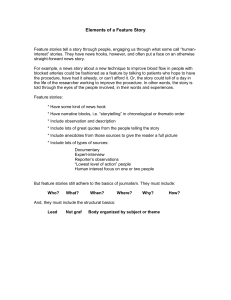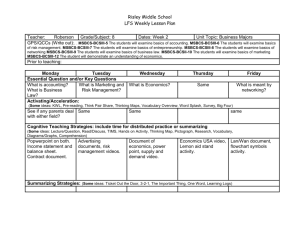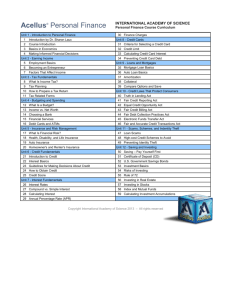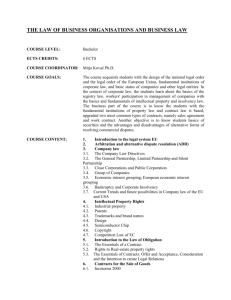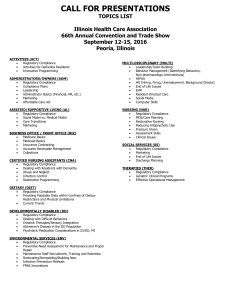the basics: building corporate innovation capabilities
advertisement
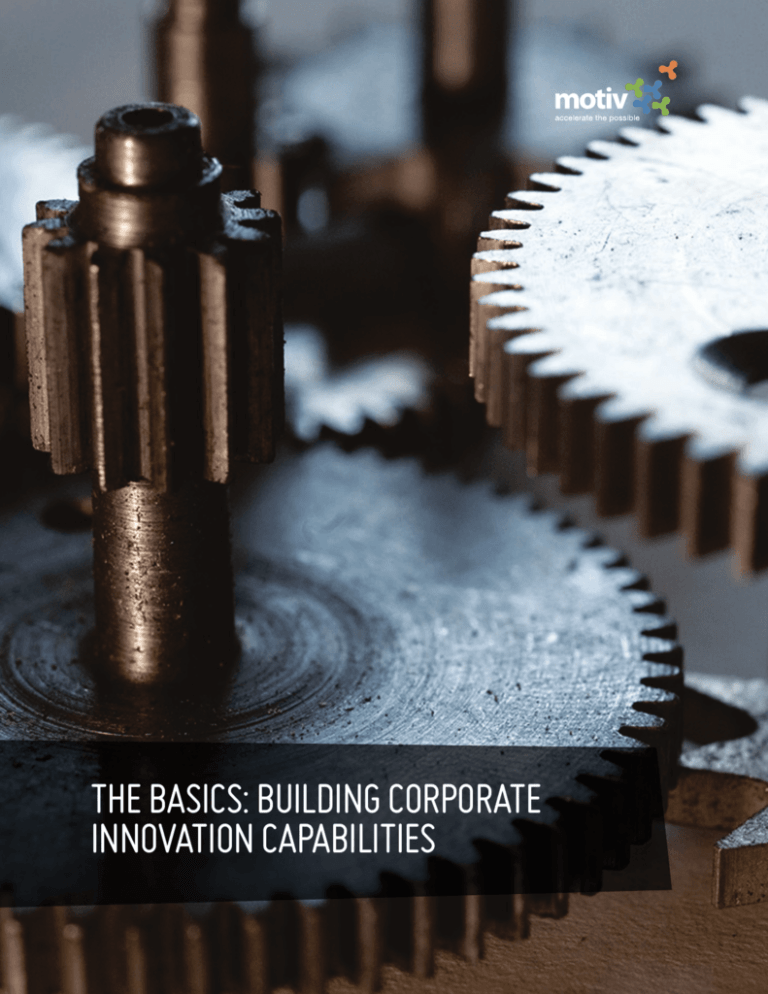
Motiv Strategies the basics: building corporate innovation capabilities The Basics: Building Corporate Innovation Capabilities 1 Motiv Strategies The Basics: Building Corporate Innovation Capabilities The idea of driving innovation in corporate environments has been building steam for more than a decade and is now solidly on the leadership agenda for management and ripe for execution across the corporate landscape. Most executives who have little experience with innovation and who have not yet made the leap to resource innovation capability development may wonder where to start. In this paper, we will shed light on four important aspects of innovation capability building that every executive should know. 1. Know why innovation is important to your business. Since innovation inherently involves risk and change, some people believe it should be avoided at all costs. Fighting such attitudes is part of the job. Any executive charged with building innovation capability, especially at the enterprise level, should be able to recite the following points that reflect the realities of his or her business: • Innovation can help drive new revenues as well as higher margins. Booz & Co.’s 2012 Global Innovation Study reports the 10 most innovative companies outperformed the top biggest spenders on R&D for several financial metrics: market cap growth, revenue growth, and earnings as a percentage of revenues. We conclude that commercial innovation (solving user needs, focus on customer experience, and new business model creation, among others) is often more powerful than technological innovation in driving value creation. • In many categories, innovation is required to sustain a leadership position. Showcasing successful innovation has become the conversation that executives want to have with Wall Street analysts, key customers, and other important stakeholders.Organizations need credible stories about what they are doing to stay on top. • Innovation will reveal new pathways for organizational development and renewal. With the basis of many innovations today rooted in technologies that help automate and scale new offerings, organizations have greater opportunity than ever to continuously modernize their operations by producing a constant flow of “what’s next.” Additionally, the best people want to work for companies that are capable of producing category breakthroughs. The Basics: Building Corporate Innovation Capabilities 2 Motiv Strategies As we’ve seen in companies such as Amazon and Apple, effective use of technology driven by motivated, mission-driven employees sets up a virtuous cycle of wins that can produce sustainable leadership positions. Anyone in charge of building innovation capabilities should have their elevator pitch about its importance down pat. In environments where “weird” stuff may be seen as suspect, wasteful, useless, or destined for failure (for which many innovation initiatives can actually qualify), a clear and uplifting message about the importance of innovation will help transcend the power of naysayers while pinpointing the precise reasons your company is implementing an innovation strategy. 2. There are many models to drive innovation; pick one or more that are right for you. At last count in our study of the topic, we have identified over a dozen models for driving innovation at the enterprise level. The biggest choices executives need to make are between developing the capability for organic growth versus relying on acquisitions (make versus buy), and whether that capability is centralized versus de-centralized. Since there are advantages and disadvantages for each choice, it is incumbent on those involved in innovation capability building to think carefully about the organization’s culture, resources, risk tolerance, talent base, and ability to partner when forging a model for innovation. Additional perspectives should also be evaluated when identifying the most appropriate model of innovation for an organization (See Figure 1 for examples). We have found that there is too much complexity to expect to make choices in understanding the pros, cons, and trade-offs of the various models solely on a theoretical basis. It is far better to understand why other companies have adopted certain models and how they are working to support particular business goals when making these choices for your own organization. It should be noted that, depending on their objectives, organizations can simultaneously employ several models of innovation. For example, Procter & Gamble, long seen as one of the most innovative companies in the world, practices technology-driven innovation within its R&D ranks, design-driven innovation within its New Business Creation teams, and supports an army of staff around the world acting as conduits for its Open Innovation program known as “Connect & Develop.” Figure 1: Several perspectives should be considered while deciding on the most appropriate model of innovation for your organization. Technology-driven Design-driven Supplier-based Customer-based Embedded Skunkworks Product-focused Experience-focused Open Closed The Basics: Building Corporate Innovation Capabilities 3 Motiv Strategies Strategy Culture Process Structure Resources 3. Successful organizational innovation requires a management framework for execution. Like any challenging endeavor, building innovation capability within a complex organizational environment requires a robust management framework. Such a framework makes innovation tangible and articulates the various activity systems and support structures required for success while also lending credibilty to the effort. Strategy refers to the goal of innovation and a plan for its execution. Creating a high-level innovation strategy and socializing it with staff serves to articulate the organization’s ambition and suggests boundaries around the type and scale of projects undertaken. Processes make development activities understandable and repeatable and serve as end-to-end road maps for delivering innovation. Common activities such as customer research, ideation, prototyping, iteration and co-creation reinforce the type of cultural norms found in innovative organizations. As innovation scales, proven processes can be taught so that more teams can participate. Structure is required to make the effort credible and tangible within the organization. Structure comes in many forms including governance, reporting relationships, incentives, portfolio management, and metrics. The aaim should be to manage innovation like any other function in the organization. A recent McKinsey study reports that 86% of executives say that the organizational structure of innovation groups has a positive influence on innovation outcomes. Figure 2: Successful organizational innovation requires a management framework. Culture establishes the environment for successful innovation. Common hallmarks of organizations with successful innovation capabilities include a culture of customer-centricity, openness, an ability to collaborate, and risk tolerance. Senior leadership involvement is crucial in setting a positive culture that supports innovation, especially given the inevitable failures associated with innovation initiatives Resources take many forms. In addition to stable funding mechanisms, the allocation of appropriate human capital—combined with a realistic understanding of the leadership time required to direct and manage innovation efforts—is also critical. Physical and virtual spaces to accommodate non-linear thinking and collaboration provide freedom and inspiration to teams. Simulation technology and creative support bring new ideas to life, speeding potential new offerings to market. The Basics: Building Corporate Innovation Capabilities 4 Motiv Strategies Outcome Action Objective Leadership Alignment Capacity Development Capability Audit Organizational Transformation What role should innovation play? How are we positioned to deliver? This is how we do it. If you build it, they will come. Facilitate leadership alignment on the purpose innovation should serve within the organization Assess culture, structure, resources, and processes for applicability to the objectivesk Redesign the structure, resources, and processes, building on existing capabilities as a foundation Create an organizational structure that understands and supports innovation •Conduct leadership interviews and deep dives •Conduct audit to understand extent of organizational development that is required to meet objectives •Invest, hire, restructure, communicate •Establish metrics that drive behavior •Host workshops to teach innovation process and management; run pilots •Reinforce role and goals of innovation in communication to staff An improved system that is optimized for generating strategic innovation initiatives An organization capable of effectively executing against innovation strategy •Create an innovation vision •Synthesize and socialize to allow key stakeholders to contribute An innovation strategy with widespread understanding and support Assessment of current innovation capabilities, including gaps and fit with strategy Roadmap for innovation capability build-out 4. Putting it all together: the steps to building a worldclass innovation capability. Large organizations that are serious about building a successful future are constantly adding new capabilities. While innovation has many inherent unknowns, it should not be thought of as materially different from building any other integrated function that is expected to become part of your organizational DNA. “So where do I begin?” you may ask. Figure 2 lists out the first steps, detailing a process for driving decision-making, capacity development, and, ultimately, organizational transformation. Authors Jeneanne Rae Figure 3: Motiv’s process for building innovation capability. President and CEO jeneanne@motivstrategies.com Ian Campbell Director ian@motivstrategies.com Colin Hudson Consultant colin@motivstrategies.com Greg Berguig Consultant greg@motivstrategies.com The Basics: Building Corporate Innovation Capabilities 5 Motiv helps leading organizations create new strategies for growth. We combine business analysis with design strategy tools to help our clients discover new opportunity spaces, develop new services and better customer experiences, and drive the change management required to enable breakthrough innovation. 811 North Royal Street Alexandria, Virginia 22314 motivstrategies.com 703.778.1051
